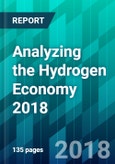A hydrogen economy is a hypothetical economy in which energy is stored and transported as hydrogen (H2). Various hydrogen economy scenarios can be envisaged using hydrogen in a number of ways. Proponents of a hydrogen economy suggest that hydrogen is an environmentally cleaner source of energy to end-users, particularly in transportation applications, without release of pollutants (such as greenhouse gasses) at the point of end use; and that these advantages may hold similarly with use of hydrogen produced with energy from fossil fuels, if carbon capture or carbon sequestration methods are utilized at the site of energy or hydrogen production.
Meanwhile, critics of a hydrogen economy argue that for many planned applications of hydrogen, direct use of energy in the form of electricity, chemical batteries and fuel cells, and production of liquid synthetic fuels from carbon dioxide, might accomplish many of the same net goals of a hydrogen economy, while requiring only a small fraction of the investment in new infrastructure.
The latest offering brings you a complete analysis of the Hydrogen Economy. Analyzing the Hydrogen Economy 2018 report contains a focused socio-economic, political, and environmental analysis of the factors affecting the hydrogen economy. The report contains an analysis of the technologies involved in hydrogen production, hydrogen storage, hydrogen conversion, and much more.
The report also carries in-depth case studies on the various countries which are actively involved in the hydrogen economy. An analysis of the technical barriers, other issues, cost effectiveness affecting the hydrogen economy, and the procedure involved in the actually implementation of the hydrogen economy are all discussed in great details inside this report. Determining the future of the hydrogen economy and the energy industry becomes a lot easier with this report.
Table of Contents
A. Executive Summary








